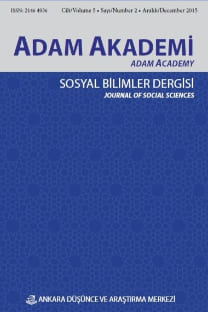YAKALAMADA BAŞARILI OLAN İKİ ÜLKE OLARAK POLONYA VE TÜRKİYE’ VE 2000-2015 DÖNEMİNDE KARŞILIKLI TİCARETLERİ
Makalenin konusu, Polonya ve Türkiye’nin karşılıklı ikili ticaretlerini de kapsayacak şekilde GSYİH büyümesinin ve istikrarının 2000-2015 yılları arasındaki karşılaştırmalı bir makroekonomik analizidir. Yazarlar, Polonya ve Türkiye’nin ekonomik performanslarını AB-28 makroekonomik göstergelerini, özellikle de Almanya ve İspanya gibi iki referans ülkeyi dikkate alarak yakalama sürecine odaklanmakta ve değerlendirmektedirler. Analiz sonuçları, ekonomik literatürde iyi bilinen, bölgesel ekonomik entegrasyonun daha gelişmiş ülkelerle yakınsama sürecinin hızlandırılmasını sağladığını teyit etmektedir. Polonya ve Türkiye yakalama konusunda başarılı olmuş ülkelerdir. Ekonomik başarılarının kaynağının sistemik reformlara ve AB ile entegrasyona (Polonya’nın üyeliği ve Türk gümrük anlaşması) bağlı olduğu varsayımı doğrulandı. Analizin bu bölümünün önemli bir sonucu, gerek Polonya gerekse Türkiye’nin ekonomik büyümesinin sürdürülmesinde 2008-2015 döneminde iç talebin önemli rol oynadığına işaret ediyor.
Anahtar Kelimeler:
Türkiye, Polonya, başarıyı yakalamak, yakınsamanın temel faktörleri, Avrupa entegrasyonu etkisi, ikili ticaret
POLAND AND TURKEY AS THE SUCCESSFUL CATCHING-UP COUNTRIES AND THEIR BILATERAL TRADE IN 2000–2015
The subject of the paper is comparative macroeconomic analysis of GDP growth and stability in the economies of Poland and Turkey in 2000–2015 as well as their bilateral trade. Authors focus on the process of catching up and evaluate effects of economic convergence of Poland and Turkey to average macroeconomic indicators for EU-28 and in particular two reference countries – Germany and Spain. Results of the analysis confirm the thesis well acknowledged in economic literature that regional economic integration enables speeding-up of the process of convergence with more developed countries. Poland and Turkey are successful catching-up countries. The assumption that the source of their economic success lies in systemic reforms and integration with the EU (Poland’s membership and Turkish customs agreement) was confirmed. An important conclusion of this part of the analysis is pointing out the role of domestic demand in maintaining economic growth of both Poland and Turkey in 2008–2015.
Keywords:
Turkey, Poland, catching up success, main factors of convergence, European integration impact, bilateral trade,
___
- Barro, Robert & Sala-i-Martin, Xavier (1990), “Economic Growth and Convergence across United States”, NBER Working Paper 3419: 1–61.
- Barro, Robert & Sala-i-Martin, Xavier (1991), “Convergence across States and Regions”, Brookings Papers and Economic Activity 1: 107–182.
- Barro, Robert & Sala-i-Martin, Xavier (1992), “Convergence”, Journal of Political Economy 100/2: 223–251.
- Ben-David, Dan & Loewy, Michael (2003), “Trade and Neoclassical Growth model”, Journal of Economic Integration 18/1: 1–16.
- Białowolski, Piotr (2005), „Produkt potencjalny w Polsce w latach 1993–2004 na podstawie funkcji produkcji”, Gospodarka Narodowa 5-6: 37–49.
- Bukowski, Maciej, Magda, Iga, Marć, Łukasz & Zawistowski, Julian (2006), Źródła i perspektywy wzrostu produktywności w Polsce, Instytut Badań Strukturalnych, Warszawa.
- Eurostat (2016), Statistical Database, http://appsso.eurostat.ec.europa.eu/.
- Grossman, Gene & Helpman Elhanan (1991), Innovation and Growth in the Global Economy, MIT Press, Cambridge Mass.
- IMF (2016), World Economic Outlook Database, http://www.imf.org/external/pubs/ft/ weo/2016/01/weodata/index.aspx.
- Knap, Renata (2015), “The competitiveness and trade potential of Poland in the merchandise trade with Turkey”, Trends in the World Economy 7: 69–88.
- Lucas Jr., Robert (1988), “On the Mechanics of Economic Development”, Journal of Monetary Economics 22/1: 3-42.
- Mucha-Leszko, Bogumiła (2014), „Wzrost gospodarczy i proces konwergencji oraz średnio i długoterminowe perspektywy zmniejszania luki rozwojowej” Pozycja gospodarcza Polski w Unii Europejskiej, Ed. Bogumiła Mucha-Leszko, Wyd. UMCS, Lublin, 15–44.
- OECD (2016a), OECD Economic Surveys: Poland.
- OECD (2016b), OECD Economic Surveys: Turkey.
- OECD (2016c), OECD.Stat, http://stats.oecd.org.
- OECD-WTO (2016), Statistics on Trade in Value Added (database), http://stats.oecd.org.
- Próchniak, Mariusz & Witkowski, Bartosz (2012), „Konwergencja gospodarcza typu beta w świetle bayesowskiego uśredniania oszacowań”, Bank i Kredyt 43/2: 25–58.
- Raiser, Martin, Wes, Marina & Yilmaz, Ayberk (2016), “Beyond convergence: Poland and Turkey en route to high income”, Central Bank Review 16/1: 7–17.
- Roaf, James, Atoyan, Ruben, Joshi, Bikas, Krogulski, Krzysztof & IMF Staff Team (2014), “25 Years of Transition Post-Communist Europe and IMF”, IMF Regional Economic Issues Special Report, International Monetary Fund.
- Romer, Paul (1990), “Endogenous Technological Change”, Journal of Political Economy 98/5: S71–S102.
- Sala-i-Martin, Xavier (1996), “Classical Approach to Convergence Analysis”, Economic Journal, 106/437: 1019–1036.
- Siwiński, Włodzimierz (2005), „Międzynarodowe zróżnicowanie rozwoju gospodarczego: fakty i teoria”, Ekonomista 6: 723–747.
- The Conference Board (2016), The Conference Board Total Economy Database, http://www. conference-board.org/data/economydatabase.
- UNCTAD (2016) , UNCTADStat, http://unctadstat.unctad.org.
- Wojtas, Monika (2014), „Innowacyjność gospodarki” Pozycja gospodarcza Polski w Unii Europejskiej, Ed. Bogumiła Mucha-Leszko, Wyd. UMCS, Lublin, 123–149.
- World Bank (2014), Evaluation of the EU - Turkey Customs Union.
- WTO (2016), Statistics database, http://stat.wto.org/Home/WSDBHome.aspx?Language=E.
- ISSN: 2146-4936
- Yayın Aralığı: Yıllık
- Başlangıç: 2011
- Yayıncı: Ankara Düşünce ve Araştırma Merkezi İktisadi İşletmesi
Sayıdaki Diğer Makaleler
AVRUPA BİRLİĞİ’NDE SÜRDÜRÜLEBİLİRLİK VE TURİZM: SÖYLEMSEL KURUMSALCI YAKLAŞIM
Bogumiła MUCHA-LESZKO, Tomasz BİAŁOWĄS
AVRUPA BİRLİĞİ’NİN İNSAN HAKLARI POLİTİKASI: DIŞ İLİŞKİLER PERSPEKTİFİNDEN BİR DEĞERLENDİRME
POLAND AND TURKEY AS THE SUCCESSFUL CATCHING-UP COUNTRIES AND THEIR BILATERAL TRADE IN 2000–2015
T O M A S Z BIA?OW ? S, B O G U M I ? A M U C H A - L E S Z K O
CONSOCIATIONAL DEMOCRACY IN THEORY AND PRACTICE: THE CASE OF POST-WAR BOSNIA AND HERZEGOVINA
